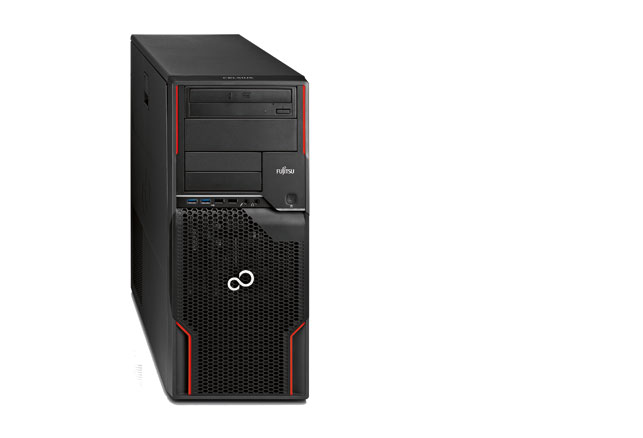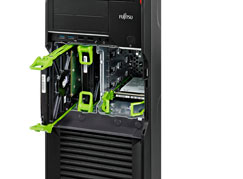Celsius is one of the oldest workstation brands in existence, dating all the way back to the late nineties when it was owned by Siemens.

Now in the hands of Fujitsu, summer 2012 saw the introduction of four new Fujitsu Celsius desktop workstations — three single processor machines, the Celsius W420, W520 and M720, and one dual processor machine, the Celsius R920.
While the Celsius W420 and W520 are really suited to entry-level to mid-range CAD use, the Celsius M720, the focus of this review, targets the mid-range to high-end. There are plenty of options for storage, memory, CPUs and GPUs, catering for a wide range of CAD-focused workflows.
The Celsius M720 shares a chassis with the single socket Celsius M520 and dual socket Celsius R920 and because of this flexibility is a pretty average size as far as workstations go (186 x 481 x 430mm) (W x D x H).
The machine is noticeably solid in construction and offers impressive ease of access. The hard drives can be added/removed direct from the front, which is great for those that like to keep their machine tucked under the desk.
Access to the GPU, memory and CPU is via the more traditional route, by pulling on the handle of a tool less side panel. This reveals the German engineered thermal management system which delivers highly efficient airflow over key components to maintain remarkably quiet operation, even under heavy load.
A low duty fan sits behind the hard drives and draws in cool air from the front of the machine. This is then routed over the CPU’s heat sink via a duct and, aided by a second fan, expelled at the rear. There’s a third fan at the bottom of the machine dedicated to cooling the add-in PCI express cards.
In the case of our review machine, there’s only one PCI Express card — a AMD FirePro W5000 GPU. This is an excellent choice for SolidWorks 2013 and PTC Creo 2.0, as demonstrated in our benchmarks tests, though be sure to install the latest FirePro driver to get the most out of the card.
Moving from AMD’s 8.982.8.0 to 9.0.0.3 driver boosted SolidWorks performance from 49 to 73 frames per second, quite an incredible amount.
For those with more demanding 3D applications the Celsius M720 can actually support two high-end GPUs, though an optional 800W power supply is required to do this.
The GPUs could be a Nvidia Quadro 6000 for graphics and Nvidia Tesla C2075 for compute. Nvidia Kepler-based GPUs are likely to follow soon.
Storage wise, the Celsius M720 is literally brimming with options: 128GB to 512GB SSDs, 250GB to 2TB 7,200RPM SATAs, 300GB to 1TB 10,000RPM SATAs and 300GB to 600GB 10,000RPM and 15,000RPM SAS drives.
The modular drive bay can be set up to support different combinations, including 8 x 2.5” drives, 4 x 3.5” drives, or 2 x 2.5” and 2 x 3.5” drives.
With this in mind our review machine’s single 256GB Micron 2.5-inch SSD looked a little lonely, though with the drive bay pre-configured to take 2 x 2.5” and 2 x 3.5” drives it’s incredibly easy to add more storage (see box out below).
On paper the Micron MTFDDAC256MAM-1K1 SSD looks to be some way off the pace when compared to some of the more modern SSDs on the market.
For example, the random read/write performance of 45,000 and 50,000 IOPS is quite a lot slower than the 80,000 to 90,000 IOPS quoted by PNY, OCZ, Intel and Samsung.
The sequential write performance of 260MB/secs is also half that of its competitors. This, coupled with the tests we carried out using the AS SSD and CrystalDiskMark benchmarks, shows there’s room for improvement here.
In terms of CPU, the Celsius M720 is focused exclusively on the Intel Xeon E5 Series. There’s a multitude of options ranging from 1.8GHz up to 3.6GHz with 4, 6 or 8 cores. Fujitsu has pretty much hit the sweet spot for CAD with our test machine.
At 3.6GHz, the Intel Xeon E5-1620 delivers best-in-class performance for single threaded CAD applications, and still offers four cores for multi-tasking and entry-level simulation or ray trace rendering.
For those for whom simulation or rendering features more heavily in their workflows the Intel Xeon E5-1660 (6 Cores, 3.30 GHz) or Intel Xeon E5-2690 (8 Cores, 2.90 GHz) will probably be better options.
Finally, with 8GB (4x 2GB) DDR3-1600 ECC RAM, our test machine is probably a little light for anything other than entry-level CAD workflows, but with eight slots and support for 8GB DIMMs, it’s easy to increase memory at time of purchase to anything up to 64GB.
Overall, the Celsius M720 looks to be an excellent proposition for CAD, particularly users of SolidWorks and PTC Creo, where the AMD FirePro W5000 excels and combines well with Intel Xeon E5-1620 to deliver solid scores in our benchmark tests.
Fujitsu still has some way to go before its brand is as strong as Dell or HP in the UK workstation market.
But with the impressive engineering and serviceability that goes into machines like the Celsius M720 it’s certainly showing the pedigree.
To view comparative scores from other workstations please click here
For details of all our specific CAD/CAM/CAE benchmarks click here
Specifications
» Intel Xeon E5-1620 Processor (3.60GHz) (Quad Core) CPU
» 8GB (4x 2GB) DDR3-1600 ECC RAM
» AMD FirePro M6000 Mobility (2GB) + (17.3”)UltraSharp (1,920 x 1,080) LED-backlit display
» 512GB SATA
» Fujitsu D3128 mainboard (Intel C602 chipset)
» Microsoft Windows 7 Professional Edition (64-bit)
» 3 year Warranty
CPU benchmarks
(secs – smaller is better)
CAD (SolidWorks 2010) – N/A
CAM (Delcam PowerMill 2010) – 1) 173 2) 272 3) 389
CAE (SolidWorks 2010 Simulation) – 89
Rendering (3ds Max Design 2011) – 256
Graphics benchmarks
(bigger is better)
CAD (SolidWorks 2010) – N/A
CAD (SolidWorks 2013) – 49
CAD (Creo 2.0 – SPECapc graphics test) – 6.19
Modular drive bay – flexible storage
The way in which the Fujitsu Celsius M720 manages its hard drives is really quite clever, so it’s worth exploring this in some detail.
In short, both 2.5-inch and 3.5-inch drives can be added with incredible ease, all from the front of the machine. There are no screws to contend with and no power or data cables to connect. With the help of two handy drive rails, everything just slots into place.
Getting access to the drives is very easy. Two clips on either side of the chassis release the plastic front grille to reveal a metal cover. A quick yank on a handle releases the cover revealing the hard drive enclosure behind.
The machine supports both 2.5-inch and 3.5-inch drives in a rather clever way. The modular enclosure is split into two sections of equal size, separated with a vertical partition.
Each module can hold 4 x 2.5-inch drives horizontally (stacked on top of each other) or 2 x 3.5-inch drives side by side (oriented vertically).
The user grips the drive on either side with two so-called ‘Easyrails’ then it’s simply a case of levering it into the drive enclosure, guided by the metal grooves.
The beauty of the system is there’s no need to connect any cables, which can be a fiddly process in a bog standard chassis design. The position of the grooves means the drive simply glides into position, automatically connecting it to the power and data ports, which are fixed at the back of the enclosure. That’s it. Job done.
Removing a drive is just as easy. Pull on the rail handles and the drive clips out. It’s an incredibly easy process, even for someone who has never seen the inside of a workstation before.
However, it is important to note that drives are not hot-swappable – i.e. you do have to turn off the machine before you make any change.
Intel Xeon E5-1620 Processor (3.60GHz) (Quad Core) CPU
GB (4x 2GB) DDR3-1600 ECC RAM
AMD FirePro W5000 (2GB GDDR5) GPU
Fujitsu D3128 mainboard (Intel C602 chipset)
56GB Micron SATA3 SSD
3 year Warranty
http://www.fujitsu.com/global/
N/A
173
272
389
89
256
N/A







